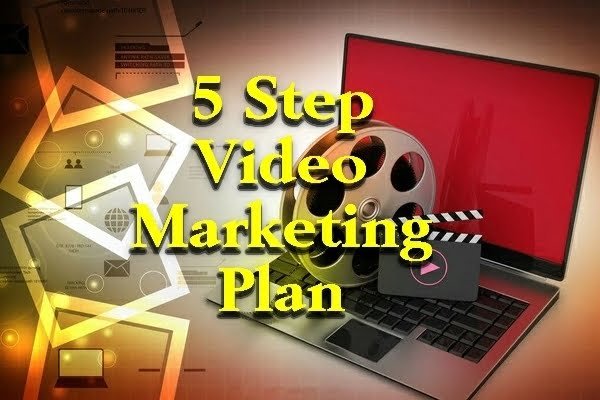5-Step Video Marketing Plan Introduction
Have you considered developing a video marketing plan but just haven’t gotten around to it yet? With this helpful article, now is the time you can make one.
Video is included on any list as part of digital marketing. You need only to look at your own behavior to see how important video use has become. The top three video platforms together make up over 22 billion daily views. Snapchat (10 billion), Facebook (8 billion), and YouTube (+4 billion).
Video ad spending is expected to reach $11.4 billion in 2017. And the average person will easily be exposed to more than 30 videos per month.
What makes video such an effective format?
Well, a video can tell a story, reach your audience at an emotional level, and be much more memorable than any text or even an image.
Using video increases engagement. A video on social media can drive a 10x higher engagement rate.
Adding video on your site can cause users to stay for an average of 2 minutes longer.
Video improves search ranking (video gives you a 53x higher likelihood of ranking on the first page of Google).
More sales (a video on a landing page can increase conversions by 80%, while 64% of users are more likely to buy a product online after they have watched a video).
5 key steps to help you create an effective video marketing plan:
1 – Know your customers
Everything in business – from the business model itself to the product to the marketing you do to sell that product – starts with an understanding of your customer.
More than ever before, people today are fully in control because they can watch (and turn off) what, when and where they want.
To capture their attention, you need to create video content that will engage your customer. And that content needs to be placed where your ideal customer will see it. Get very clear on who your customers are, what they care about, and know their needs and desires.
Be sure you also take a look at what your competition is doing. Understand how they are addressing the customer’s needs. See how you can choose to be different and ideally, better.
2 – Create strong content
It goes without saying – you need to create high quality videos, but it’s less obvious as to what that actually means. What it doesn’t mean is having a huge expense account with an impressive production budget.
Actually, a more authentic and down-to-earth approach is often better, especially with younger audiences (although basic image quality is still important).
Having good content usually does one of three things:
1. Inspires (telling the ‘why’ behind your business, your backstory)
2. Educates (useful information such as “how-to” tutorials)
3. Entertains (comedy or excitement).
Whichever one you choose for your video marketing plan, you’ll want to be sure to create content that engages your customer, fits your brand, and works towards your ultimate goals. A funny cat video may be entertaining but how does it move your business forward?
You’ll also want to make sure that you’re consistent with everything from the format, tone of voice, to the publishing schedule. So that you build your brand in a unified way to create trust and loyalty among your fans.
Below are a few successful brand examples you can see for yourself, each with a different approach to video content on their YouTube channel:
Inspires
Go Pro (leveraging user-generated content, UGC)
Entertains
DollarShaveClub (great use of humor)
3 – Distribute your content
Once you have created your video content, you need to decide where you’re going to broadcast it. Generally this includes YouTube and your website. However, there are other platforms that are relevant to your business and will target your audience as well.
You may also want to use your Email Service provider. You can distribute your videos by embedding them into your landing pages or broadcast them by means of email campaigns. By adding “video” in the subject line can increase open rates by 7-13% and click-through rates by 200-300%!
When you distribute the content online, you want to make sure it can be organically discovered. You can do this by tapping into highly searched topics in the first place and making the most of the metadata including titles, tags and descriptions.
You also want to make sure your content can be easily shared. The run length is important here: videos less than 15 seconds long are shared 37% more often than those between 30 seconds and one minute.
Any amount you have to promote your video content will go much further if you have optimized it first for natural web traffic.
4 – Blend it into your marketing channels
As you create and distribute your video content, it’s important that it doesn’t sit alone, isolated and separate from the rest of your marketing activities. Consider where this video content resides along the customer journey, their path to purchase, and what role each video has in that journey.
What is the clear call to action that you want to include at the end of the video? Where do you want to direct that web traffic? Do you want the user to click through to a landing page, to subscribe to your mailing list, or follow you on social media? Maybe you want to give them a coupon discount to use when they buy from you for the first time?
By thinking through the different steps you want your audience to take will ensure that you make effective use of the traffic. And you especially don’t want to lose potential customers now that you have them engaged.
5 – Track and examine your results
So that you know if you’ve been successful and learn from your campaigns, you need to set clear objectives for your video marketing plan in the first place. Then make sure you track and measure your results.
Where does video marketing fit in your overall strategy? Are you using it to build awareness of a new product, to increase engagement with your brand, to drive traffic to your website, drive online or offline sales, or maybe grow customer loyalty and increase testimonials and recommendations?
Depending on the specific objective, you can then choose the right measure that will tell you if you’ve reached that objective. Things like video views for awareness, attention span and drop-off rates for engagement, or click-through rates for website traffic.
Now you’re ready to create your own video marketing plan and get them out into the world. Good luck!

